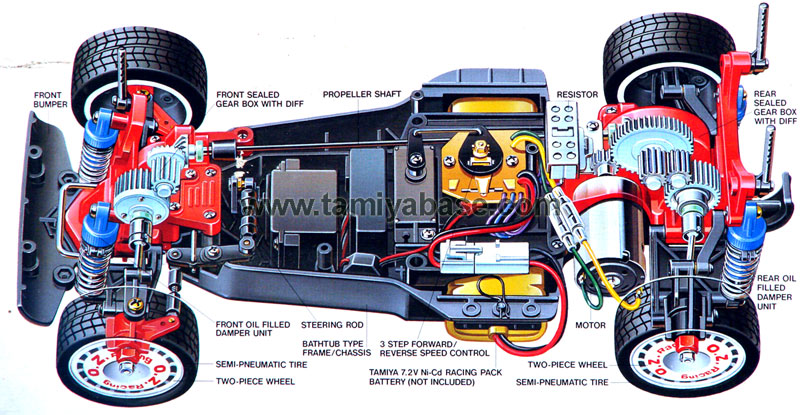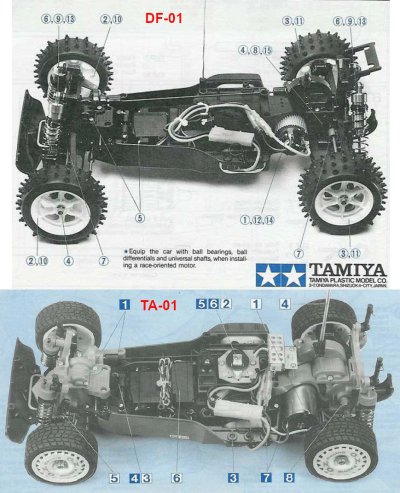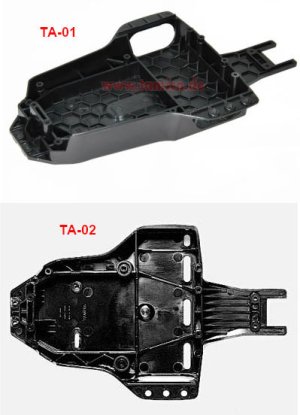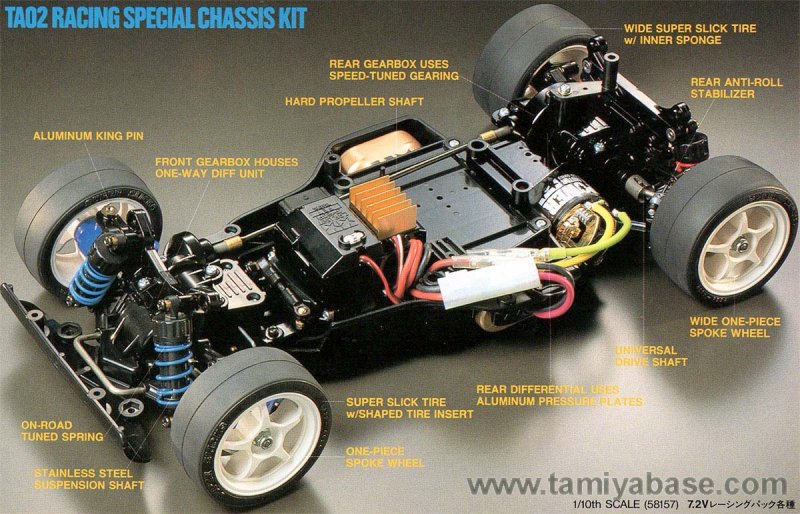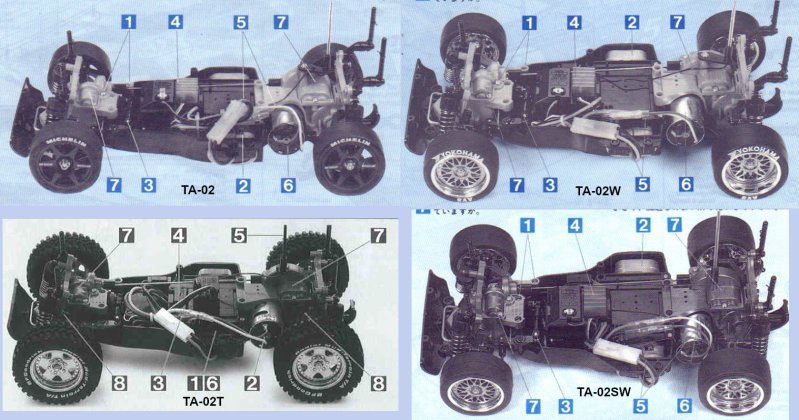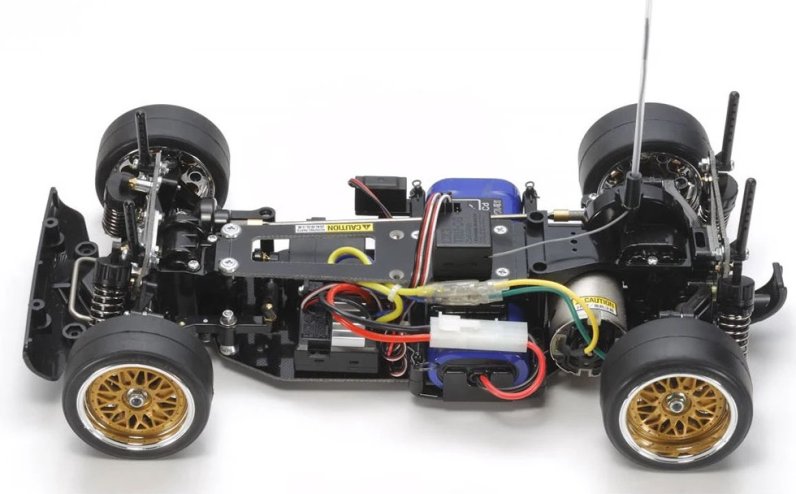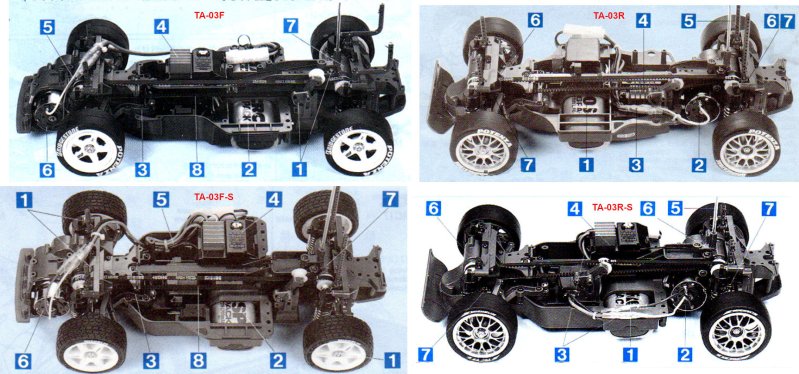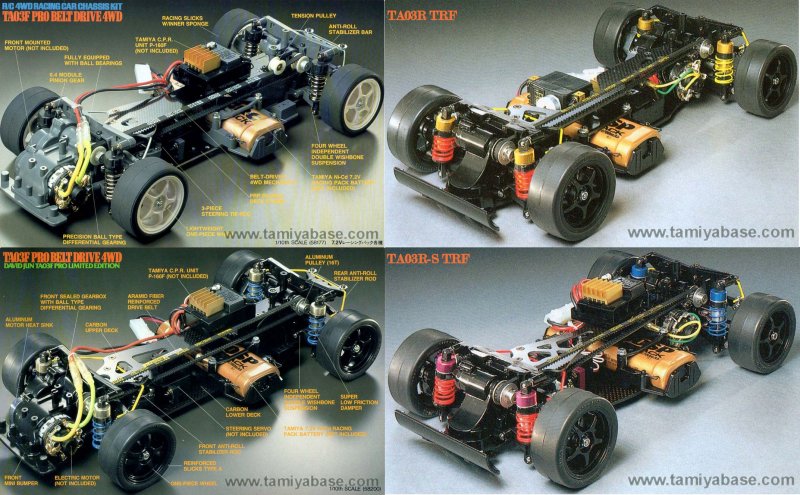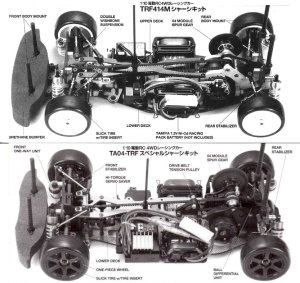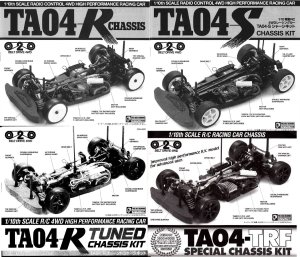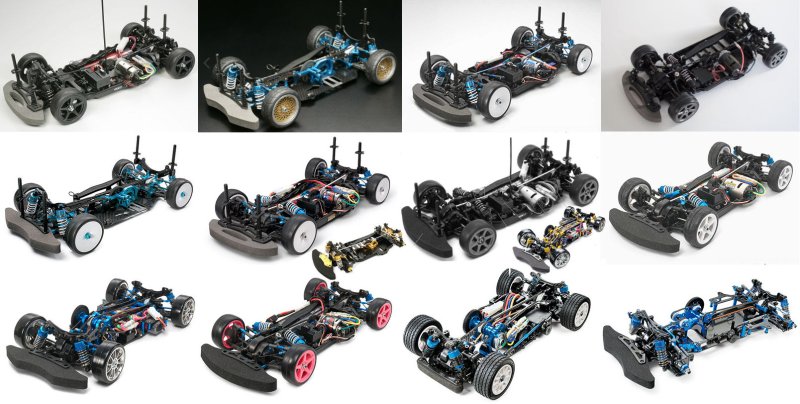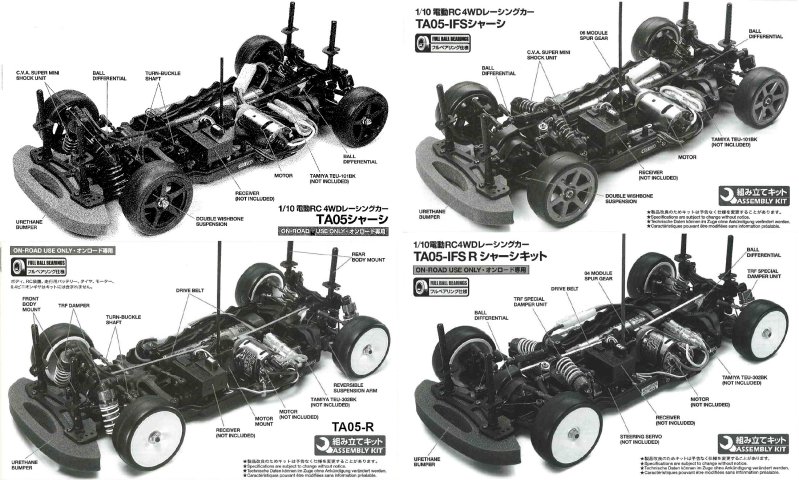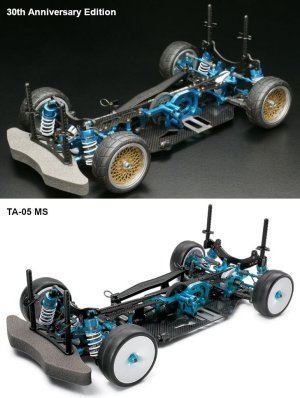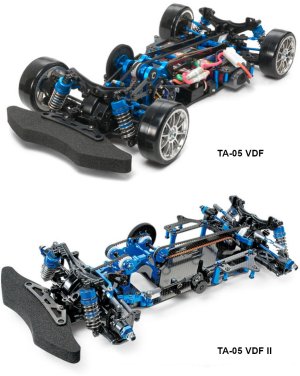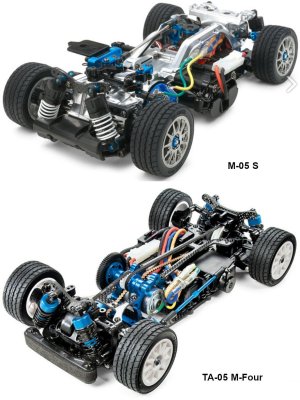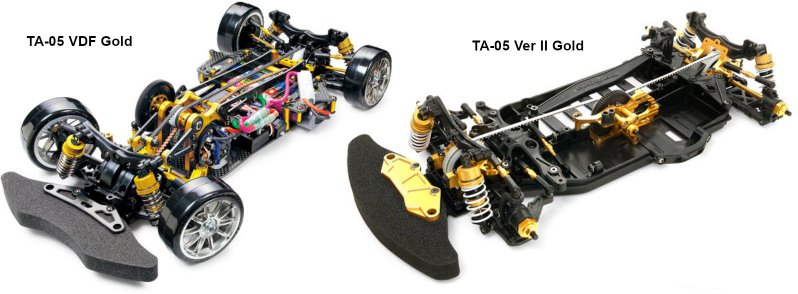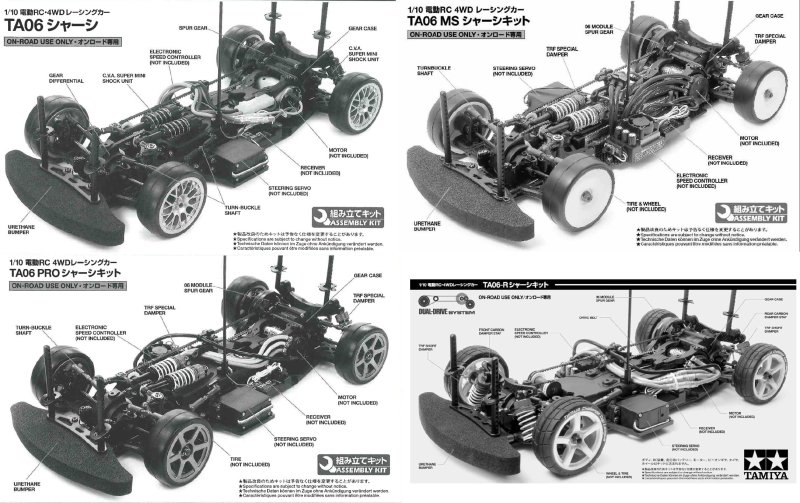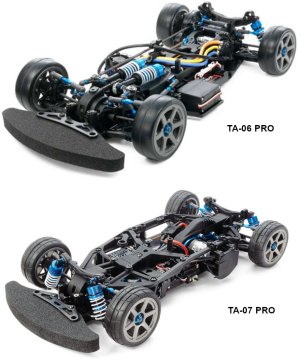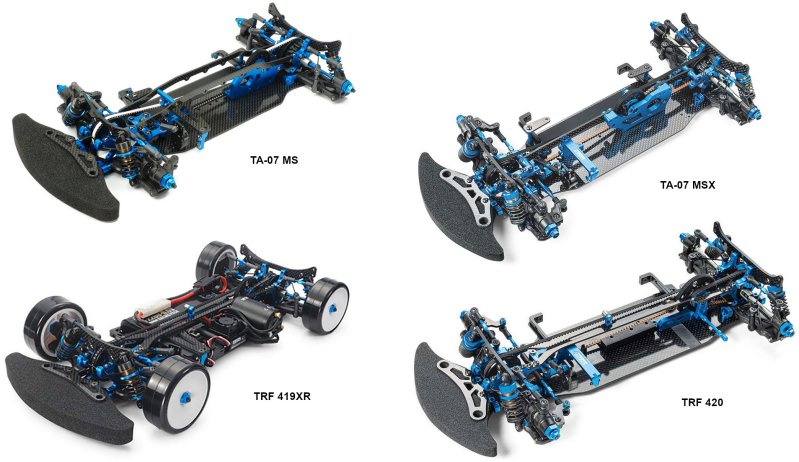The Tamiya TA series of medium to high end touring car chassis began in 1991 (or even slightly earlier with the DF-01) and continues to be advanced up the present day. Let’s take a look at the history of this illustrious line.
TA-01 (58096)
This chassis was first available in July 1991. It was never available as a standalone chassis but was first released with a Celica GT-4 body. It was closely derived from the DF-01 buggy chassis using the same chassis tub and gearboxes but shorter arms and shocks. Features included shaft drive AWD, 260mm wheelbase, mid motor, plastic bathtub chassis, front gear differential, rear ball differential, 0.6 mod spur and pinion, plastic CVA shocks, double wishbone suspension with fixed length, plastic dog bone axles, and plastic bearings. This model was originally configured for a mechanical speed control using a BEC. The front and rear gearbox housings were molded in red. The kit included a standard silver can motor. There were 10 bodies available with this chassis between 1991 and 1995 and then a few re-releases later.
TA-02 (58128)
This chassis was first available in November 1993. It was first released with an Alfa 155 body. This chassis was very similar to the TA-01 with the same gearboxes and differentials, but shorter chassis tub, new angled rear suspension arms resulting in the same wheelbase, new steering knuckles with larger inner bearings, and updated CVA shock design. 1 This model was configured for an electronic speed control. The kit included a standard silver can motor. There were 17 bodies available with this chassis between 1993 and 1996, 3 of which used a different suspension arm configuration that would eventually come to be known as the TA-02 T.
TA-02 Special (58157)
In 1995 there was a Racing Special Limited Edition version of this chassis 2 released as a standalone chassis kit without a body or motor (a Sport Tuned motor was recommended). Changes included an improved rear ball differential with aluminum pressure plates and cartridge thrust bearing, a 24T pinion instead of 21T, a choice of 3 one piece spur gears (66T, 69T, & 74T) instead of a two piece 72T gear, universal axles instead of dog bones, stainless steel suspension shafts instead of screw pins, rear sway bar, front one-way instead of open gear differential, aluminum kingpins, special harder damper springs (front blue, rear red), hardened drive shaft, and special slick tires with inner foams. Surprisingly it did not include ball bearings.
TA-02 W (58144)
This variant was first available in September 1994. It was never available as a standalone chassis but was first released with a Nissan 300ZX GTS body. The “W” stands for “Wide”. The chassis was the same as the regular TA-02 but with an increased and staggered track width. The front was widened by reverting to TA-01 knuckles. This chassis was intended to use narrow front wheels and wider rear wheels, both with increased offset. There were 3 bodies available with this chassis between 1994 and 1996, all GT cars.
TA-02 SW (58172)
This variant was first available in March 1996. It was never available as a standalone chassis but was first released with a Taisan Porsche 911 GT2 body. The “SW” stands for “Short Wide”. The chassis was the same as the regular TA-02 except with a shorter 236mm wheelbase and an increased and staggered track width. The rear was shortened by reverting to TA-01 suspension arms. This chassis was intended to use narrow front wheels and wider rear wheels, both with increased offset. There was originally only a single Porsche body option, but another edition with the same body and a new livery was released in 2015.
TA-02 SW FRP (84431)
This variant was first available in December 2015. It was only ever used for special editions of the Porsche 934 RSR including the orange Jägermeister 40th anniversary edition, the black edition, and the white Vaillant 45th anniversary edition. This is not officially recognized as a different chassis than the TA-02 SW, but it is a distinct upgraded edition. Upgrades included the 53166 FRP double deck chassis set, FRP front and rear shock towers, CVD axles instead of dog bones, hardened drive shaft, and aluminum motor mount. A similar double deck chassis set in carbon fiber later became available as 47479 which resulted in a very similar configuration.
TA-02 T (58495)
Depending on how you measure, this variant was first available in July 2011. The same variant was previously used on the Toyota Prerunner, Chevy S-10, and Ford F-150 racing trucks beginning in 1994 but not officially called TA-02 T until it was used on the re-released F-150 in 2011. The “T” stands for Truck. This chassis was the same as the regular TA-02 but with 17T rather than 21T pinion, TA-01 front and rear suspension, TA-01 steering knuckles, and bigger tires.
TA-02 S (58654)
This variant was first available in March 2018. It was only ever available with the Lancia 037 body. This chassis was exactly the same as the TA-02 SW except for the wheels and front bumper.
TA-03 F PRO (58177)
This chassis was first available in June of 1996. It was released as a standalone chassis kit without a body or motor (a Dyna-Run Super Touring motor was recommended). It was a completely new model unrelated to the TA-02 and the first belt drive chassis from Tamiya. The “F” stands for front motor which indicates that Tamiya was already planning for the rear motor option or they wouldn’t have bothered with the specifier. Features included single belt drive, AWD, 257mm wheelbase, front motor, double deck FRP chassis, front and rear ball diffs, 0.4 mod spur and pinion, plastic CVA shocks, double wishbone suspension with fixed length, dog bone axles, ball bearings, and sway bars. The PRO version was actually available a few months before the regular version.
TA-03 F (58185)
This variant was first available in October of 1996. This simplified version of the PRO was never available as a standalone chassis but was first released with Kure Nismo GT-R body. Changes included gear instead of ball diffs, screw pins instead of suspension shafts with E-clips, coarser 0.6 mod spur and pinion instead of 0.4, plastic bathtub chassis instead of FRP plates, metal bushings instead of ball bearings, and no sway bars. This version added an E tree with a different belt tensioner and removes the J tree since a separate battery box was not needed with a bathtub chassis. The kit included a standard silver can motor. There were 9 bodies available with this chassis between 1996 and 1999 making it the most common variant.
TA-03 R-S (58193)
This variant was first available in Jun of 1997. It was never available as a standalone chassis but was first released with a Porsche 911 GT1 body. The “R-S” stands for “Rear Short”. It’s interesting that the short version of the rear motor chassis was released prior to the standard version (but only by a couple of months). The chassis was the same as the F except that the motor gearbox was located in the rear instead of the front. There were no changes to the gearbox itself (same A parts tree). Note that the gearbox was translated to the back without rotating it. In the F chassis the motor sat in front of the front axle, so if the gearbox were rotated to the back then the motor would have been behind the rear axle like a 2WD buggy. However, the motor actually sat in front of the rear axle. The model used a much shorter front gearbox (modified B parts tree) with shorter front shocks. The 20mm shorter wheelbase was achieved by using a new chassis tub. There were 3 bodies available with this chassis between 1997 and 2001 and a street version of the Porsche 911 GT1 20 years later.
TA-03 F PRO Special (58200)
In 1997 there was a David Jun Limited Edition version of the PRO based on the ROAR and NORRCA winning chassis with upgraded parts including carbon chassis instead of FRP, color coded metal shocks (blue springs, silver caps), aluminum pulleys, front one-way, front universal axles, heat sink, metal uprights, and a reinforced drive belt. The kit came with wheels and tires but no body or motor (a Dyna-Run Super Touring motor was recommended).
TA-03 R (58203)
This variant was first available in October of 1997. It was never available as a standalone chassis but was first released with Nissan R390 GT1 body. This chassis took the R-S back to the original 257mm wheelbase, but did so using a new, 3rd chassis tub which moved the battery forward for better weight balance. There were 5 bodies available with this chassis between 1997 and 1999.
TA-03 F-S (58218)
This variant was first available in June of 1998. It was never available as a standalone chassis but was first released with Toyota Corolla WRC body. This chassis was the same as the F except with a 20mm shorter wheelbase achieved by using a different chassis tub. There were 2 bodies available with this chassis between 1998 and 1999.
TA-03 R TRF (58227)
This variant was first available in December of 1998 and marks the first ever use of the “TRF” moniker on a kit. It was released as a standalone chassis kit without a body or motor (a Dyna-Run Super Touring motor was recommended). It took all of the upgrades of the 58200 David Jun Special Edition and applied them to the rear motor variant. Additional changes included a different style front one way replacing the ball diff instead of being on the pulley shaft, metal steering cranks, and color coded shocks (springs red front and yellow rear, gold caps).
TA-03 R-S TRF (58243)
This variant was first available in July of 1999. It was the same as the R TRF except with a shorter wheelbase and different colored shocks (springs red front and blue rear, caps magenta front and blue rear). The battery sat further back so the weight balance was a bit different.
TA-03 F Drift (49377)
In 2005 there was a limited edition drift version of the PRO which, as far as I can tell, was exactly the same except for the tires. The PRO was no longer in production by that time, so it included the 53306 FRP Chassis Upgrade Set to make a PRO out of a standard TA-03 F.
TA-04 PRO (58261)
This chassis was first available in June 2000. It was released as a standalone chassis kit without a body or motor (a Dyna-Run Racing Stock motor was recommended). It was a completely new model unrelated to the TA-03 but, based on the timeline and a large number of shared design features, the TA-04 seems to have been derived from the prototype TRF 414X. Features included dual belt drive, AWD, 257mm wheelbase, mid motor, double deck FRP chassis, front and rear ball diffs, 0.4 mod spur and pinion, plastic CVA shocks, double wishbone suspension with adjustable upper arms, dog bone axles, ball bearings, and sway bars. 112T, 120T, and 128T spur gears were included in the kit. The PRO version was actually available a few months before the regular version.
TA-04 (58266)
This variant was first available in October 2000. This simplified version of the PRO was never available as a standalone chassis but was first released with a Ferrari 360 body. Changes included gear instead of ball diffs, coarser 0.6 mod spur and pinion instead of 0.4, plastic bathtub chassis instead of FRP plates, a mix of plastic bushings and bearings instead of full ball bearings, a basic instead of a high torque servo saver, and no sway bars. This version added a U tree with a different belt tensioner and removed the J tree since a separate battery box was not needed with a bathtub chassis. The kit included a standard silver can motor. There were 2 bodies available with this chassis in 2000 before it was replaced with the S variant.
TA-04 S (58274)
This variant was first available in May 2001. It was available as a standalone chassis kit without a body or motor (a Sport Tuned motor was recommended) or as a complete kit with a body and silver can motor. I never found an explicit definition of the “S”, but this seem to be a “Sport” version of the basic chassis released only a year later to improve a very small number of things. Changes were limited to full ball bearings and turnbuckles. There were 3 bodies available with this chassis in 2001.
TA-04 R (58282)
This variant was first available in June 2001 and included a lot of changes. It was available as a standalone chassis kit without a body or motor (a Sport Tuned motor was recommended), a tuned chassis variant, or as a complete kit with a body and silver can motor. The “R” presumably stands for “Racing”. It appears to be an amalgamation of the PRO and the S with additional improvements to bring it closer to the newly released TRF 414M. This chassis used the ball diffs, sway bars, high torque servo saver, and 0.4 mod gears from the PRO, the turnbuckles and a carbon reinforced version of the plastic bathtub (different mold) from the S, and added a machined instead of stamped motor plate, and a carbon instead of plastic upper deck. The new aluminum shocks, bulkhead beam, C-hubs with ball head kingpins, CVD axles, and front radius arms were from the TRF 414. The use of the harder carbon reinforced chassis tub allowed for the use of set screws in the lower suspension arms to adjust ride height like the PRO. There were 3 bodies available with this chassis between 2001 and 2002.
TA-04 SS (58290)
This variant was first available in May 2002. The additional “S” stands for “Short”. This variant was exactly the same as the S except that it has a 10mm shorter wheelbase achieved with a new set of lower suspension arms. It was never available as a standalone chassis but was first released with Toyota MR-S body. There were 2 bodies available with this chassis in 2002.
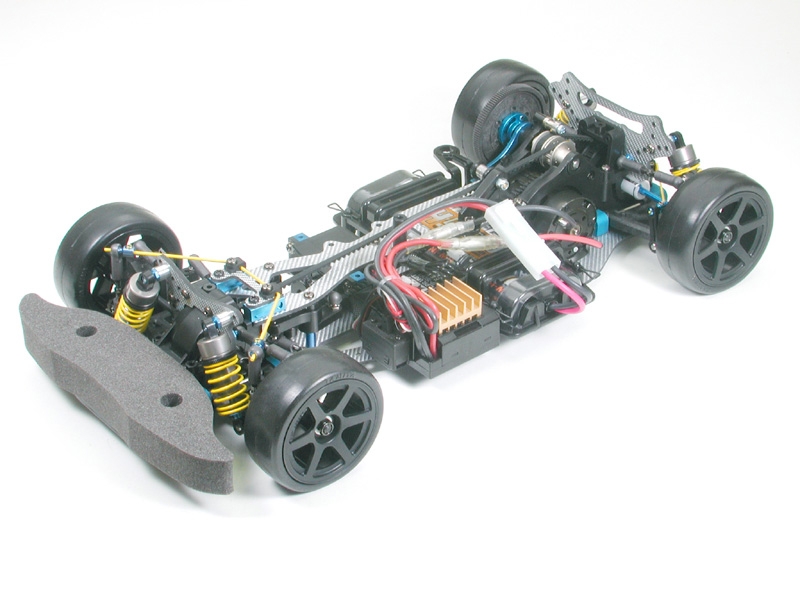
TA-04 TRF (49278)
This limited edition variant was first available in March 2003. It was released as a standalone chassis kit without a body or motor (a Sport Tuned motor was recommended). This was a very unusual model. The TA-03 had already established the precedent of having a super deluxe TRF version, but this one took it a step further by using SSG carbon fiber plates 3 for the chassis and shock towers. These plates used a bit of metallic colored thread to give them a unique silver appearance. This model started with the R, converted to a double deck carbon chassis, and made additional changes such as ball joint suspension mounts, front one-way, center one-way, a different front sway bar attachment, and clamping wheel hexes. Except for the SSG, all of these changes seem to have come from the TRF 414.
TA-04 R Tuned (49297)
In 2003 there was a Tuned Limited Edition version of the R released as a standalone chassis kit without a body but included a Super Stock Type-R motor. It started with the R and adds the SSG carbon upper chassis plates and shock tower from the TRF version, but none of the other options. I’m not sure why this existed only months after the TRF came out, but it originally cost only slightly more than the PRO or R but much less than the TRF so it was quite a bargain with that motor and carbon parts included.
TA-05 (58345)
This model was first available in June 2005. It was never available as a standalone chassis but was first released with a Ferrari F430 body. While sharing the suspension with the TA-04, it was a mostly new design. Features included equal length dual belt drive, AWD, 257mm wheelbase, mid motor, plastic bathtub chassis, front and rear ball diffs, identical modular front and rear gearboxes, 0.6 mod spur and pinion, plastic CVA shocks, double wishbone suspension with turnbuckle upper arms, dog bone axles, and ball bearings. This chassis used cam shaped bearing mounts for the differentials to allow belt tension adjustment. Labelled suspension mounts were also used which could be mixed and matched to adjust arm toe angle. Both features were introduced on the TRF 415, carried over to the TA-05, and persist on Tamiya high end touring car chassis to this day. The kit included a standard silver can motor. There were 8 bodies available with this chassis between 2005 and 2006.
TA-05 Special (49400)
In 2006 there was a 30th Anniversary Limited Edition deluxe version of the Porsche 934 RSR Turbo that used a variant of the TA-05. It had so many differences from the standard TA-05 that it probably should be considered a different chassis. In fact, it had very little in common with a basic TA-05 and never even referred to the TA-05 in the manual or on the packaging. It was nearly the same as the TA-05 MS which didn’t come out until a year later. Changes included a dual deck carbon chassis, metal diff cups, 0.4 mod spur and pinion gear, aluminum motor mount, aluminum bulkheads, aluminum suspension mounts, aluminum steering cranks and bridge, carbon reinforced reversible suspension arms, aluminum CVD axles, aluminum uprights, aluminum turnbuckles, TRF shocks, carbon shock towers, high torque servo saver, and clamping wheel hexes. A large number of these parts are unique to this one model.
TA-05 R (49418)
This limited edition variant was first available in April 2007. It was released as a standalone chassis kit without a body, motor, or tires. The “R” presumably stands for “Racing”. You might imagine that this would just be a more widely available version of the 49400 special edition, but it wasn’t. It still represented a major upgrade from the basic chassis though. Changes from the basic TA-05 included 9 balls per diff instead of 8, metal diff cups, finer 0.4 mod gears, metal center bulkhead brace, reversible suspension arms, aluminum suspension mounts, CVD axles, aluminum turnbuckles, TRF shocks, sway bars, and high torque servo saver.
TA-05 IFS (58389)
This variant was first available in June 2007. It was never available as a standalone chassis but was first released with an EBBRO 350R body. “IFS” stands for “Inboard Front Suspension”. This version moved the front shocks from their traditional vertical orientation and mounted them laterally behind the front axle. This seems to have been the first Tamiya chassis to do this. The removal of the front shock tower allowed the use of bodies with lower front profiles. Apart from the shock configuration, the only other difference between this chassis and the basic TA-05 was the use of the newer reversible suspension arms. There were 4 bodies available with this chassis between 2007 and 2008, all from the Japanese Super GT series.
TA-05 MS TRF (42103)
This limited edition variant was first available in July 2007. It was released as a standalone chassis kit without a body, motor, or tires. I consider this a TRF chassis given that it was labelled as such both in the manual and on the packaging even though the TRF 415 was still available at the same time. The “MS” stands for “Satoshi Maezumi”, a Tamiya racing team driver. This chassis was effectively equivalent to the 49400 special edition released a year before. It used the same copious supply of aluminum parts, shocks, and suspension. The mechanical differences included the use of the slightly improved ball differential from the R, sliding ball cups, front one-way 4, and sway bars. The carbon chassis plate was slightly modified to bring the motor mount forward for better weight balance. This resulted in different length drive belts.
TA-05 IFS R (49491)
This limited edition variant was first available in May 2008. It was released as a standalone chassis kit without a body, motor, or tires. Just as there was a “Racing” version of the standard TA-05 chassis, this was the R version of the Inboard Front Suspension variant. Like the previous R, it included 9 balls per diff instead of 8, metal diff cups, finer 0.4 mod gears, metal center bulkhead brace, aluminum suspension mounts, aluminum turnbuckles, CVD axles, TRF shocks, sway bars, and high torque servo saver.
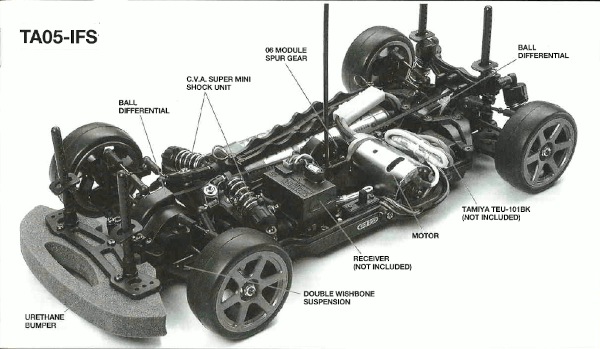
TA-05 Ver II (58435)
This variant was first available in June 2009. It was available as a standalone chassis kit without a body, motor, or tires, a gold chassis variant, or as a complete kit with a body and silver can motor. The Version II used inboard front suspension, so it seems to be an update to the IFS rather than to the original TA-05. In fact, by this time the IFS version had completely supplanted the original version, so only IFS versions of the chassis were available. Changes included a new (but very similar) chassis tub, an updated motor mount, 12 balls per diff instead of 8, 37T pulleys instead of 36T, slightly updated suspension mounts, updated uprights, updated front shock bridge, updated steering cranks, and updated battery holder. There were 7 bodies available with this chassis between 2009 and 2011.
TA-05 Ver II Special (92217)
This limited edition variant was first available in December 2009. It was released as a standalone chassis kit without a body or motor. This variant of the Ver II included upgrades such as TRF dampers, a front one-way, aluminum rockers, and high torque servo saver with aluminum horn.5
TA-05 VDF (84132)
This limited edition variant was first available in July 2010. It was released as a standalone chassis kit without a body, motor, wheels, or tires. “VDF” stands for “Vertical Double Frame” which was based on the twin carbon upper plates which greatly stiffen the chassis. This variant was intended as a drift chassis and is so different from the others that it is hard to know what to even use for comparison. It used a carbon chassis and lots of aluminum like the MS, but was otherwise quite different. While the other TA-05 variants had put the motor just ahead of the rear axle and used equal (or nearly equal) length drive belts, the VDF moved the motor far forward and put the spur gear above it which resulted in very different length belts and a forward weight bias. All of the aluminum motor mount and center bulkhead parts were completely different than the other variants. The aluminum steering parts were also all completely new and different. The rear ball differential was replaced with a solid spool to make it easier to kick the back end out. The front 8 ball differential was from the standard TA-05. The front and rear bulkheads and suspension were shared with the R as are the CVD axles. The chassis used the TRF shocks from the MS, but with softer springs. Extensions were added to the steering knuckles to provide a larger maximum steering angle. The kit did not come with wheels or tires, but hard drift tires were intended. There were no sway bars.
TA-05 Ver II R (84159)
This limited edition variant was first available in October 2010. It was released as a standalone chassis kit without a body, motor, or tires. Just as there was a “Racing” version of the standard TA-05 and IFS chassis, this was the R variant of the Ver II. Compared to the regular Ver II this variant added carbon reinforced suspension arms, a metal center bulkhead brace, aluminum suspension mounts, aluminum turnbuckles, aluminum CVD axles, TRF shocks, sway bars, low friction drive belts, and high torque servo saver. The chassis also came with special hideous pink wheels.
TA-05 M-Four (84255)
This limited edition variant was first available in December 2011. It was released as a standalone chassis kit without a body, motor, or tires. This chassis was a completely different thing than any of the other variants. It used some of the basic details of the TA-05 but modified them to fit on a smaller (210mm) wheelbase to work with bodies for the M series of chassis (only short wheelbase bodies were compatible). Unlike any of the M chassis though, this one was 4WD. The M-Four carried over the front and rear gearboxes from the Ver II and applied them to a new, shorter carbon chassis plate. Because there was so little space available between the front and rear bulkheads, a new aluminum center bulkhead and motor mount supported only 380 sized motors. Other features included sealed gear differentials instead of ball differentials, new aluminum steering cranks and bridge, carbon shock towers, carbon upper deck, M chassis suspension, CVD axles, and TRF shocks. There was no room for a regular sized battery pack, so the model was sized for 6.6V Li-FE battery packs available only in Japan. 6
TA-05 VDF II (84294)
This limited edition variant was first available in June 2012. It was released as a standalone chassis kit without a body, motor, or tires. This revision took the prior Vertical Double Frame drift chassis that came out two years earlier and made it even more complicated and different. This most obvious change was the addition of a 3rd belt between the spur and an intermediate pulley. 7 Other changes included a new carbon chassis plate, 37T pulleys instead of 36T, 12 balls in the front differential instead of 8, a new centered bulkhead and motor mount, much longer steering cranks with optional attach points, default 112T spur instead of 128T, 38T instead of 39T pinion, and a repositioned steering servo.
TA-05 VDF Gold (84188)
In 2011 there was a special Gold Limited Edition version of the VDF chassis. All of the aluminum parts in this chassis were anodized in gold instead of blue.
TA-05 Ver II Gold (84275)
In 2012 there was a special Gold Limited Edition version of the Ver II chassis. You might imagine that this would just be an alternate version of the previous Ver II Special chassis with all of the aluminum parts anodized in gold instead of blue, but it was more than that. Tamiya apparently wanted to send off the TA-05 in style. Beyond the gold aluminum coloring, changes included vertical front shocks instead of IFS, machined center bulkhead and motor mount, machined front and rear bulkheads, machined bumper support, aluminum turnbuckles, aluminum rear swing shafts, and clamping wheel hexes.8
TA-06 (58488)
This model was first available in June 2011. It was never available as a standalone chassis but was first released with a Nissan GTR body. While sharing the suspension with the TA-04 and TA-05, it was a mostly new design. The rear axle was gear driven from the motor while the front axle was driven by a belt (similar to the TA-03R). The drive belt was located on the side of the chassis to allow a central longitudinal battery to be inserted from a hatch on the bottom of the chassis tub. Because the belt was off to the side, an additional very short belt was needed to drive the front pulley. Additional features included AWD, 257mm wheelbase, rear motor, plastic bathtub chassis, front and rear sealed gear diffs, 0.6 mod spur and pinion, plastic CVA shocks, choice of longitudinal inboard or traditional front shock locations, double wishbone suspension with turnbuckle upper arms, dog bone axles, and ball bearings. The kit did not include a motor which is very unusual for a full kit with a body. There were 6 bodies available with this chassis between 2011 and 2013. This was the last TA chassis to be offered as a full kit with a body. After this the TA series would be chassis only.
TA-06 PRO (58492)
This variant was first available in June 2011 (the same time as the regular version). Just like with the TA-03 and TA-04, the PRO variant was a more deluxe version that was released as a standalone chassis kit without a body, motor, or tires. Changes included CVD axles, aluminum turnbuckles, TRF shocks, and a high torque servo saver.
TA-06 PRO Special (92243)
In 2011 there was a special limited edition version of the PRO chassis that included a bunch of upgrade parts in the box. Upgrades included front double cardan axles, front one-way, rear ball differential, aluminum steering bridge and cranks, sway bars, and machined motor plate. 9
TA-06 PRO Special II (84330)
In 2012 there was another special limited edition version of the PRO chassis that included nothing extra except a set of front double cardan axles. 10
TA-06 MS (84352)
This limited edition variant was first available in June 2013. It was released as a standalone chassis kit without a body, motor, wheels, or tires. Unlike the MS version of the TA-05, this one did not include any TRF markings. The “MS” stands for “Satoshi Maezumi”, a Tamiya racing team driver. This was a full carbon chassis ultimate version the TA-06. Compared to the PRO, changes included carbon chassis plate, aluminum pulley mount, aluminum steering crank (on the opposite side of the chassis), aluminum center bulkheads, metal differential gears, front solid spool, front double cardan axles, and a carbon upper deck. This is the only carbon chassis I’ve ever seen to have a removable central carbon plate for accessing the battery from the bottom.
TA-06 R (84378)
This limited edition variant was first available in March 2014. It was released as a standalone chassis kit without a body, motor, wheels, or tires. Was this “Racing” version an upgrade to the PRO or a downgrade from the MS? A bit of both, with other differences. Most notably, this variant of the chassis lost the ability to use Inboard Front Suspension and could use traditional suspension only. Compared to the PRO, changes included aluminum suspension mounts, aluminum pulley mount, new suspension arms from the TRF418, sway bars, and carbon shock towers 11. Many of the plastic parts were also carbon reinforced.
TA-07 PRO (58636)
This model was first available in July 2016. It was released as a standalone chassis kit without a body, motor, or tires and in fact, no TA-07 model would be offered with a body. There was no “standard” version so the PRO was the bottom of the range.12 This chassis returned to a single belt design like the TA-03, but now with a serpentine routing which could accommodate 3 different motor position options (varying by about 10mm each) without changing the belt. The new space frame style of construction made for a very stiff chassis, even in plastic. The Inboard Front Suspension option was gone, so the front shocks were oriented vertically. Additional features included AWD, 257mm wheelbase, mid motor, identical front and rear bulkheads, front and rear sealed gear diffs, 0.6 mod spur and pinion, TRF shocks, double wishbone suspension with turnbuckle upper arms, CVD axles, high torque servo saver, enclosed spur gear, and ball bearings. The suspension arms were carried over from the TA-06 R.
TA-07 R (84433)
This limited edition variant was first available in March 2018. It was released as a standalone chassis kit without a body, motor, wheels, or tires. Like the other “Racing” versions of TA chassis, it was an upgrade to the PRO with a lot of option parts. Compared to the PRO, changes included a low friction drive belt, aluminum suspension mounts, aluminum ball joints, metal center and counter pulleys, aluminum motor mount posts, steel diff cross shafts, rear aluminum drive cups, front solid spool, aluminum steering cranks and bridge, front double cardan axles, rear aluminum swing shafts, sway bars, carbon shock towers, and an aluminum servo mount 13. Despite the very long list of upgrades, virtually none of these were noticeable at first glance so the PRO and R looked extremely similar.
TA-07 MS (42326)
This limited edition variant was first available in November 2018. It was released as a standalone chassis kit without a body, motor, wheels, or tires. The “MS” stands for “Satoshi Maezumi”, a Tamiya racing team driver. This an ultimate version the TA-07 with a carbon lower deck and twin vertical carbon upper decks. The MS was quite different than the R, with other changes including aluminum upper and lower bulkheads, finer 0.4 mod gears (96T instead of 64T spur, 27T instead of 20T pinion), 20T instead of 18T center pulley, machined motor mount, aluminum shaft bridge supporting center pulleys, front solid spool, different carbon shock towers, different aluminum and carbon servo mount, aluminum battery stays, and big bore shocks. At this point the top of the line TA chassis had become pretty much equivalent to a TRF chassis and cost about the same.
TA-07 RR (47445)
This limited edition variant was first available in June 2020, two years after the first R. It was released as a standalone chassis kit without a body, motor, wheels, or tires. If one R was good, then two R’s were obviously better 14. This was not just a simplified version of the MS, and in fact it shared much more in common with the original R. Compared to the R changes included new suspension from the TRF420, different carbon shock towers, an adjustable servo horn, big bore dampers, and dual carbon upper decks. The use of the TRF420 suspension opened up a huge range of toe and roll center options.
TA-07 MSX (42364)
This limited edition variant was first available in December 2020 and at the time was the most expensive Tamiya touring car chassis ever (priced higher even than any of the TRF chassis). It was released as a standalone chassis kit without a body, motor, wheels, or tires. This chassis took the previous MS special edition and upgraded it even further using TRF420 parts in the same way that the RR improved upon the R. Compared to the MS, changes included modified aluminum bulkheads, modified machined motor mount, modified shaft bridge, modified carbon upper decks, new suspension from the TRF420, modified aluminum servo mount, and modified aluminum battery stays. This version of the chassis supported only the middle or rear motor position options, but not the front position. The kit included both a carbon fiber and an optional aluminum lower deck as well as optional carbon shock towers for standard instead of super short big bore shocks.
Footnotes:
- The TA-02 is so similar to the TA-01 that it could have just been considered a variant instead of a new chassis.
- They didn’t start calling these special editions TRF until the TA-03, but this follows the same pattern.
- What is SSG? I can find no reference to the existence of this material except for RC chassis.
- I’m always amazed that so many racing drivers use front one-ways. We hates them, Precious. We hates them.
- I was never able to find the manual for this kit so the details are from published data.
- This requirement for a small battery greatly limits this chassis’ utility outside of Japan. I don’t know how well this model sold, but I know it was on clearance for a long time at TamiyaUSA for 60% off.
- It’s not clear to me what the point of the extra belt is. It was already possible to use different sized front and rear pulleys to get a countersteer setup. With the 3rd belt, I guess this can now be done without changing the lengths of the primary belts. The gap between the primary belts also leaves room for the motor allowing the pulleys to sit lower and the motor to be more centered.
- I was never able to find the manual for this kit so the details are from published data and photos.
- I was never able to find the manual for this kit so the details are from published data. It probably did not even have a unique manual since the extra parts were all separately available upgrades.
- Why was this even released as a separate model number? It seems like a very strange thing to do unless there were chronic problems with the original axles.
- Interestingly, the R had carbon shock towers even though the MS did not.
- It seems that at about this time, pretty much all complete touring car kits came on the TT-01 chassis. The TA and TB chassis lines were now high end only.
- For someone intent on a top end chassis, the R version is a vastly better value than buying the upgrades for the PRO.
- Objectively the RR is probably better, but subjectively I prefer the regular R because it retains the signature space frame brackets that the RR loses.
_____________________________
Written by Eric Albrecht
Visit Eric's personal site with lots of build threads.

